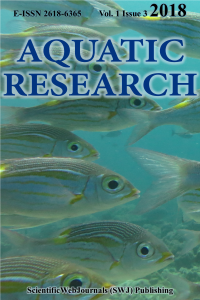Short Communication
BEHAVIOR AND RESPONSE OF JAPANESE CATFISH (Silurus asotus) IN CAPTIVITY PROVIDED WITH AN ARTIFICIAL MICROHABITAT MOSAIC
Abstract
Rearing of Japanese catfish (Silurus asotus) requires special considerations for designing of
facilities and management. Information on its biology in natural environment
provides ideas for developing suitable culture systems. For this species,
underwater artificial microhabitat structures are needed to perform its normal
behavior. The fish shows distinct preferences for some designs based on visual
cues and its decision to make use of these structures is guided by other cues
probably related to light and water flow. Microhabitat structures can make a
real difference to managing stress of captivity in this species. Absence of a
suitable structure causes ‘habitat bottleneck’ that develops aggressive
behavior. However, the intraspecific antagonistic behavior gives way to social tolerance among conspecifics.
Microhabitat metrics is important in addition to physical attributes of the
structure so as to allow social grouping in the fish under favorable
conditions.
References
- Dulmaa, A. (1999). Fish and fisheries in Mongolia. In: Fish and Fisheries at Higher Altitudes: Asia (Petr, T., ed.) pp. 187-236. FAO, Rome.
- Gaillard, J-M., Hebblewhite, M., Loison, A., Fuller, M., Powell, R., Basille, M., Moorter, B.V. (2010). Habitat–performance relationships: finding the right metric at a given spatial scale. Philosophical Transactions of the Royal Society of London- Biological Science, 27, 2255-2265.
- HMC (2015). Stress in Fish: Symptoms and Solutions. The Hartz Mountain Corporation, NJ, USA.
- Huckstorf, V. 2012. Silurus asotus. Amur Catfish. The IUCN Red List of Threatened Species Version 2012.2. www.iucnredlist.org IUCN, ISSN 2307 – 8235
- Katano, O. Saitoh, K., Koizumi, A. (1988). Scatter-spawning of the catfish, Silurus asotus. Japanese Journal of Ichthyology, 35(2), 203-211.
- Kim, I.S., Choi, Y., Lee, C.L., Lee, Y.J., Kim, B.J., Kim, J.H. (2005). Illustrated Book of Korean Fishes. Kyo-Hak Publishing Company, Korea.
- Oldfield, R.G. (2011). Aggression and welfare in a common aquarium fish, the Midas cichlid. Journal of Applied Animal Welfare, 14(4), 340-360.
- Perterson, M.S., Comyns, B., Rakocinski, C. (2004). Defining the fundamental physiological niche of young estuarine fishes and its relationship to understanding distribution, vital metrics, and optimal nursery conditions. Environmental Biology of Fishes, 71, 143-149.
- Shapawi, R., Shaleh, S.R.M. (2015). Biology of aquaculture animals- learning from nature to manage culture, pages 37-67. In: Aquaculture Ecosystems: Adaptability and Sustainability (Mustafa, S. & Shapawi, R.,eds.), John Wiley, West Sussex, UK.
- Sinclair, A.R.E., Fryxell, J., Caughley, G. (eds). (2005). Wildlife Ecology and Management, 2nd edition, Blackwell Science, London, UK.
Year 2018,
Volume: 1 Issue: 3, 136 - 139, 13.04.2018
Abstract
References
- Dulmaa, A. (1999). Fish and fisheries in Mongolia. In: Fish and Fisheries at Higher Altitudes: Asia (Petr, T., ed.) pp. 187-236. FAO, Rome.
- Gaillard, J-M., Hebblewhite, M., Loison, A., Fuller, M., Powell, R., Basille, M., Moorter, B.V. (2010). Habitat–performance relationships: finding the right metric at a given spatial scale. Philosophical Transactions of the Royal Society of London- Biological Science, 27, 2255-2265.
- HMC (2015). Stress in Fish: Symptoms and Solutions. The Hartz Mountain Corporation, NJ, USA.
- Huckstorf, V. 2012. Silurus asotus. Amur Catfish. The IUCN Red List of Threatened Species Version 2012.2. www.iucnredlist.org IUCN, ISSN 2307 – 8235
- Katano, O. Saitoh, K., Koizumi, A. (1988). Scatter-spawning of the catfish, Silurus asotus. Japanese Journal of Ichthyology, 35(2), 203-211.
- Kim, I.S., Choi, Y., Lee, C.L., Lee, Y.J., Kim, B.J., Kim, J.H. (2005). Illustrated Book of Korean Fishes. Kyo-Hak Publishing Company, Korea.
- Oldfield, R.G. (2011). Aggression and welfare in a common aquarium fish, the Midas cichlid. Journal of Applied Animal Welfare, 14(4), 340-360.
- Perterson, M.S., Comyns, B., Rakocinski, C. (2004). Defining the fundamental physiological niche of young estuarine fishes and its relationship to understanding distribution, vital metrics, and optimal nursery conditions. Environmental Biology of Fishes, 71, 143-149.
- Shapawi, R., Shaleh, S.R.M. (2015). Biology of aquaculture animals- learning from nature to manage culture, pages 37-67. In: Aquaculture Ecosystems: Adaptability and Sustainability (Mustafa, S. & Shapawi, R.,eds.), John Wiley, West Sussex, UK.
- Sinclair, A.R.E., Fryxell, J., Caughley, G. (eds). (2005). Wildlife Ecology and Management, 2nd edition, Blackwell Science, London, UK.
There are 10 citations in total.
Details
| Primary Language | English |
|---|---|
| Subjects | Hydrobiology |
| Journal Section | Articles |
| Authors | |
| Publication Date | April 13, 2018 |
| Submission Date | April 5, 2018 |
| Published in Issue | Year 2018Volume: 1 Issue: 3 |
is licensed under a CreativeCommons Attribtion-ShareAlike 4.0 International Licence
Diamond Open Access refers to a scholarly publication model in which journals and platforms do not charge fees to either authors or readers.
Open Access Statement:
This is an open access journal which means that all content is freely available without charge to the user or his/her institution. Users are allowed to read, download, copy, distribute, print, search, or link to the full texts of the articles, or use them for any other lawful purpose, without asking prior permission from the publisher or the author. This is in accordance with the BOAI definition of open access.
Archiving Policy:
Archiving is done according to TÜBİTAK ULAKBİM "DergiPark" publication policy (LOCKSS).


